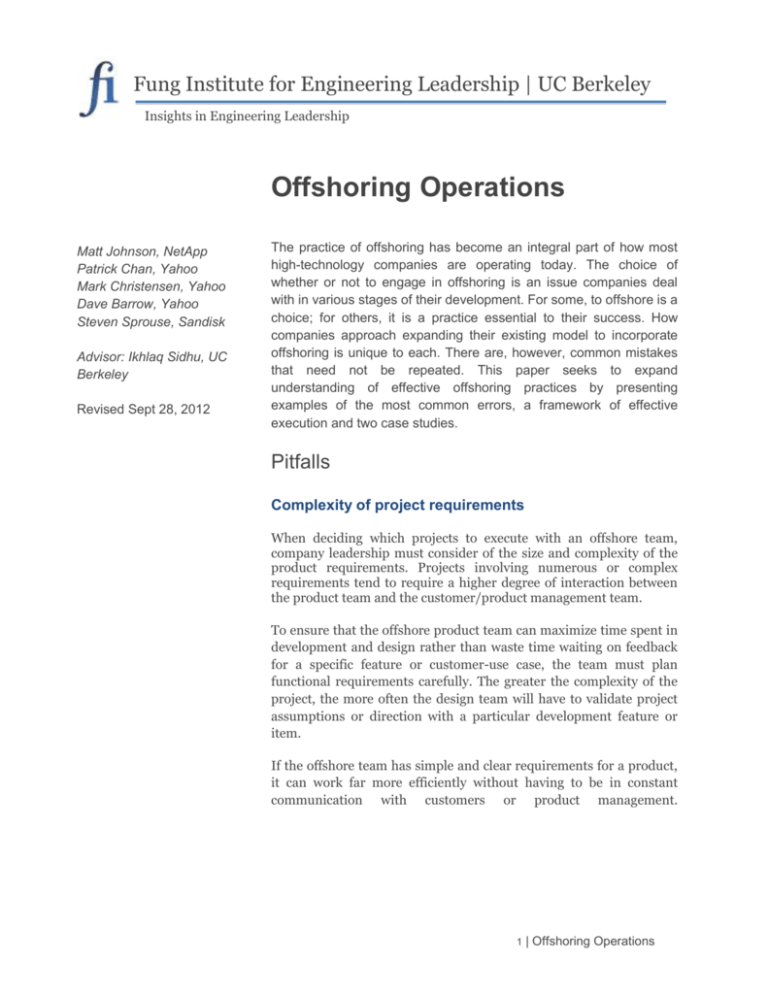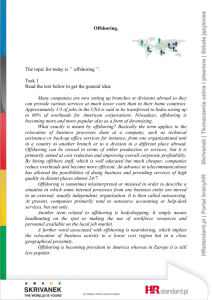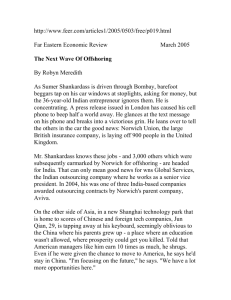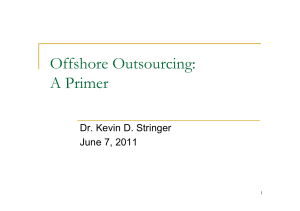Offshoring Operations - Δ Innovation Engineering
advertisement

Fung Institute for Engineering Leadership | UC Berkeley Insights in Engineering Leadership Offshoring Operations Matt Johnson, NetApp Patrick Chan, Yahoo Mark Christensen, Yahoo Dave Barrow, Yahoo Steven Sprouse, Sandisk Advisor: Ikhlaq Sidhu, UC Berkeley Revised Sept 28, 2012 M The practice of offshoring has become an integral part of how most high-technology companies are operating today. The choice of whether or not to engage in offshoring is an issue companies deal with in various stages of their development. For some, to offshore is a choice; for others, it is a practice essential to their success. How companies approach expanding their existing model to incorporate offshoring is unique to each. There are, however, common mistakes that need not be repeated. This paper seeks to expand understanding of effective offshoring practices by presenting examples of the most common errors, a framework of effective execution and two case studies. Pitfalls Complexity of project requirements When deciding which projects to execute with an offshore team, company leadership must consider of the size and complexity of the product requirements. Projects involving numerous or complex requirements tend to require a higher degree of interaction between the product team and the customer/product management team. To ensure that the offshore product team can maximize time spent in development and design rather than waste time waiting on feedback for a specific feature or customer-use case, the team must plan functional requirements carefully. The greater the complexity of the project, the more often the design team will have to validate project assumptions or direction with a particular development feature or item. If the offshore team has simple and clear requirements for a product, it can work far more efficiently without having to be in constant communication with customers or product management. 1 | Offshoring Operations Overestimating cost savings Many teams begin estimating cost savings from offshoring a project with the premise that the offshore team can complete the entirety of the project. This premise fails to take into account the management and direction of the project. According to Dr. Jones, a basic rule of thumb is that at least 20% of a project should be performed on-site.1 This ensures a measure of “control” and direction over the project as a whole. Another common pitfall in the area of perceived cost savings is the misconception that using offshore personnel on-site will cost less than US based workers. In reality, the cost differential between offshore staff and US based workers is typically insignificant. Jones recommends that no more than 30% of the work should be done by on-site offshore personnel. Cultural mismatch According to Eran and Tija, organizational and team culture are malleable, but national culture is very difficult to change.2 This becomes potentially problematic when we consult the table above of countries listed by Power orientation index, a measure of the emotional distance between supervisors and subordinates. Cultures with high indices are structured from the top down and thus have greater emotional distance, whereas cultures with lower indices place less import on hierarchy. It is imperative that business leaders pay attention to the types of national culture supervisors and subordinates are from respectively to facilitate effective collaboration and minimize conflict. 1 Offshore Outsourcing: Trends, Pitfalls, and Practices (Part 1 in a Series), Sourcing and Vendor Relationships Advisory Service by Dr. Wendell Jones, Senior Consultant, Cutter Consortium, sourced from pdfbookfiles.info/ebook-files/offshore-outsourcing-trends-pitfalls-and-practices.html 1 | Offshoring Operations The figure above compares three nations’ dimensions of national culture as defined by Geert Hofstede.2 They are, from left to right, as follows: 1. Power Distance: The degree to which individuals accept a hierarchical order. 2. Individualism: The degree to which a people identify with “I” as opposed to “We”. 3. Masculinity: Assertive vs. cooperative 4. Uncertainty Avoidance: The degree to which members of society are uncomfortable with uncertainty and ambiguity. 5. Long-Term Orientation: Short-term oriented societies believe in absolute truths and focus on quick results. Long-term oriented societies believe truth is situational and are more inclined to save and invest. This research provides a guideline for understanding the origin of intercultural conflicts. For example, a work environment in which employees from a country with a higher Power orientation index are expected to collaborate with employees from a country that favors individualism and rejects managerial hierarchy may be prone to conflicts. Likewise, if one team is from a culture that is averse to uncertainty, its members may favor more modeling, feasibility, and up-front specification. A culture that tolerates uncertainty, on the other hand, may be inclined to “dive in” and undertake rapid prototyping and an iterative design approach. "GEERT HOFSTEDE." Countries. Web. 04 Apr. 2012. <http://geerthofstede.com/countries.html>. 2 2 | Offshoring Operations Lack of clearly documented agreements When engaging with an offshore company, it is important to establish contracts that govern the expectations of both the offshoring and offshored entities. There are numerous areas that, if taken for granted, can present significant risk of failure of the offshore relationship. Agreements between companies need to cover many areas3: Area Legal Scope and cost Examples Intellectual property rights, brand protection, arbitration What is delivered, cost, overruns, penalties Measurements Security SLAs, benchmarking Access control, authentication, encryption, source code management Quality Standards Test procedures, software development practices Agreements can take time to author, but if they are left incomplete or error-ridden, it can lead to poor execution of the project, cost overruns, or the termination of the offshore project before its completion. On a day-to-day level, agreements determine the interaction between the on-site and offshore teams. Defined procedures for specific test environments, test procedures, development practices and etc. are necessary to meet the expectations of the outsourced team. Finally, differences in culture and methods of communication can endanger the project. Documenting project discussions clearly via email or formal documents can resolve many of these risks. Time zone differences Accommodating time zone differences is one of the most challenging issues that companies face when offshoring. Often, it is the degree of time difference between potential teams that drives many of the organizational decisions involved in setting up an offshore team. The problem is exacerbated when more than two teams need to collaborate. While teams in either site can extend work hours to maximize work time overlap, it is often better to find ways to minimize inter-site dependencies and make each site as self-sufficient as possible. Several techniques have been developed to deal with time zone differences, such as: 1. Timeshifting 2. Nearshoring 3. Follow-the-Sun 4. Round-the-Clock “Risks, Benefits, and Challenges in Global IT Outsourcing: Perspectives and Practices”, Dhar & Balakrishnan, 2006. 3 3 | Offshoring Operations Timeshifting is the simplest and most common strategy. One team will shift their work hours so as to achieve overlap with another team. According to “nearshoring” strategy, work centers are be established in lower cost countries that are in roughly the same time zone as the home office. For example, Japan nearshore to China, and US companies nearshore to Mexico or Central America. This strategy seeks to minimize the time zone difference between on-site and offshore teams. Follow-the-Sun breaks an ongoing task into hundreds or thousands of smaller tasks. Each site works on a portion of the tasks, then hand it off to another site. This approach allows for almost constant progress on the project. Follow-the-Sun is appropriate for “ongoing, well-suited tasks”4 and requires the team to follow a structured process with daily documentation and communication. Round-the-clock coordinates schedules of teams so that there is someone working at any point in a 24-hour cycle. Work is routed to sites that are operating in their local time zone. This technique is well suited for “highly granular transactions that typically take just a few minutes to complete.”4 High turnover rates The attrition rate on any outsourced project can be expected to be at least 15% within a year, according to Schwartz5 and a study by Yiu and Saner6. All trends indicate that this voluntary job change rate is increasing. According to both Schwartz and Yiu, the cause of this high attrition rate can be attributed to the enormous success of outsourcing and the finite number of candidates. The critical cost of this turnover is manifested in the recurring cost of training new personnel at the price of the overall productivity of the respective team. Senior members of these teams are expected to train new personnel at the cost of their personal productivity. The secondary effect of this high turnover rate is the amount companies are obliged to spend on salary packages to attract new candidates or to keep current staff from leaving. This not only adds to the cost of the project, but it also diminishes the value proposition of cost reduction from on-site employees. Confusing operational effectiveness and strategy One of the most basic mistakes companies make in offshoring considerations is to confuse operational effectiveness with company strategy. Stated best by Bean5, “Operational effectiveness is about working cheaper or faster. Strategy is about the creation of a long-term competitive advantage, which for technology companies is usually the ability to create innovative software.” Companies move into offshoring relationships with the intention of creating their product in a more cost-effective environment. However, these companies often lack thoughtful planning as to what parts of the products or service can be outsourced effectively. Outsourcing the core of a product without being able to sustain innovation or the core value of the product would be a grave mistake. Underestimating level of training necessary and the need for an onboarding plan Carmel, Erran, and J. Alberto. Espinosa. I'm Working While They're Sleeping: Time Zone Separation Challenges and Solutions. [United States]: Nedder Stream, 2011. Print. 83. 4 4 | Offshoring Operations When considering a new site, companies must pay attention to the process, costs, and opportunity costs of the time taken by the incumbent team to train the offshore team. The training plan should account for reduced productivity of the new employees as they adapt to their new roles. Avoiding internal competition As responsibility is transferred from one site to another, the incumbent team’s concerns about job security and status will become an issue. In many cases, where offshoring is undertaken to allow the incumbent team to work on higher value projects, it is important to ensure that they understand the benefits of offshoring to themselves as well as the company. Framework In order to best address the what, where, and how of foreign outsourcing, a methodology will be presented. The most effective framework came from “Strategic Outsourcing” by Maurice Greaver. Greaver outlines a multi-step methodology to be followed to achieve successful outsourcing, summarized below: 8-step methodology 1. Planning a. Form a Cross Functional Team to study, explore and implement the outsourcing option. i. Evaluate the proposed project/process to be outsourced against certain criteria to verify its “outsourceability” 1. Does it require significant management involvement? 2. Does it require significant communication and interaction with other parts of the company? 3. Does it have complex requirements? Answers of yes to any of the above 3 items would mean the project is a poor candidate for outsourcing. In general, the following fields tend to be offshoreresistant: Healthcare (Doctors, nurses), Real estate sales, Construction, Marketing, Government, Law. ii. Project leader selection is critical iii. Ensure all necessary functions are represented on CFT iv. Engage advisors v. Hire external consultants/experts b. Risks should be identified and understood, and should contain mitigation plans c. Ensure regular project status reports/communication 2. Exploring Strategic Implications a. Determine how outsourcing fits in with your company’s long-term strategies i. Corporate Vision ii. Current and future core competencies 5 | Offshoring Operations iii. Current and future competitive advantages iv. Current and future cost structures 3. Analyzing costs/performance. Cost is by far the number 1 reason for outsourcing. A comprehensive make vs. buy cost comparison must be made. The “make” costs should take into account “activity costs” for a specified volume, inclusive of labor and overhead; raw materials, inclusive of shipping, storage, handling and overhead; and cost of invested capital. The “buy” costs should take into account the providers quote for a specific volume; anticipated future pricing adjustments, ongoing costs that don’t disappear when outsourcing, plus one-time costs associated with outsourcing. a. Measure existing communications) costs of activities (including salaries, benefits, travel, b. Develop cost comparison models i. Include future costs and capital costs ii. Careful not to overestimate cost savings 1. Rule of thumb is substantial savings accrues only when 70% or more of the work is performed off-site c. Analyze current and future performance i. Measure current performance (Productivity, Quality, Cycle Times, Output) ii. Estimate cost of poor performance (Impact of poor quality and longer cycle times on overall organization’s costs) 4. Selecting Country/Location. China and India are current undisputed champions of offshore outsourcing due to their low wage levels and enormous pools of labor. Up and coming countries are Israel, Ireland, Australia, Indonesia, Canada, Singapore and the Philippines. a. Cost Considerations i. Raw Materials ii. Labor iii. Communication iv. Transportation v. Capital vi. Energy b. Workforce Considerations i. Skilled workers/engineers ii. Education iii. Language iv. Understanding of Culture v. Communication vi. Time zone differences c. Business Environment i. Government policy/Political Stability 6 | Offshoring Operations ii. Tax benefits iii. Economic growth iv. Infrastructure v. IP 5. Selecting Providers a. Develop evaluation criteria b. Identify qualified providers based on evaluation criteria c. Prepare detailed RFP’s d. Provider visits e. Evaluate proposals and select a prime provider candidate 6. Negotiating Terms a. Reach an agreement on specific terms i. Well-defined scope of service ii. Performance standards iii. Pricing iv. Management and control v. Binding agreement clearly documented vi. Exit provisions 7. Transitioning Resources a. Addressing human resource issues b. Transfer factors of production to outsource provider i. People ii. Equipment iii. Facilities 8. Managing Relationships a. Monitor performance and employee turnover b. Set up oversight council c. Evaluate results d. Resolve problems e. Build strong, committed relationship with provider 7 | Offshoring Operations Case Studies Dell Michael Dell founded Dell Computer in 1984 while he was attending the University of Texas at Austin. Dell's initial success led to the company’s rapid growth in both domestic and international markets. Since then, Dell has grown to become one of the largest Personal Computer manufacturers in the world. However, during its development, Dell committed many of the common mistakes of offshoring. In the 1990s, the leaders at Dell saw that credit card and airlines companies were successful in reducing operating costs by opening customer support call centers in India. Lured by a huge talent pool and potential savings, Dell opened its first customer call center in Bangalore, India in 2001. HP, IBM, Apple and Dell dominated the PC and laptop market in 2003. One of the differentiators between the major players was the customer support provided to customers who bought a new desktop or laptop. Apple had been at the top of the American Customer Satisfaction Index (ACSI) during this period with scores in the 80s out of 100. HP and Dell were second and third in customer satisfaction, respectively. However, in 2003, Dell had a rapid decline to an index score of 62 and was forced to take action. In November 2003, Dell stopped routing all technical support calls to the Bangalore center for the Optiplex desktop and Latitude laptop lines. The calls were routed to US based call centers, and the event became a black eye for the company. The media latched on to the story and portrayed Dell’s attempt at offshoring as a failure. Despite the negative press in the US, the call center was still fielding calls from other parts of the world. There were a number of factors that contributed to the call center’s failure to satisfy US based customers. One factor was hiring practices of the management in Bangalore. They were not identifying and retaining talent. This led to training issues, and managers tried to cover their tracks by giving staff scripted answers, which customers did not appreciate. A second factor was the rapid growth Dell was experiencing at the time. There was simply more call demand than offshored call centers could handle at their staffing levels, exacerbating the first factor. Call volume also led to extremely long hold times and very poor quality connections to the customer. The last factor was that fundamentally, Dell lost sight of the key metric for the call center: customer satisfaction. Staff measured call volume levels, number of calls handled and tickets processed, but failed to take customer satisfaction into account. Despite this setback, Dell pressed on and expanded its operations in India. Then CIO Randy Mott’s goal was to continue to reduce operational cost. Mott’s goal was to drop the IT budget from 1.91% of revenue to 1.44% of revenue. After the Bangalore event, he was quoted as saying “[Dell] has learned its lesson”. Dell opened its second call center in Hyderabad India in the same year it opened the first. Two more call centers were built in the following years, in Chandigarh (2004) and Gurgaon (2006). Dell also capitalized on the demand for US base technical support centers. In December 2008, Dell asked that customers pay $12.95 per month for a guarantee that their technical support center would be US-based. They also offered a similar $99 option new PC owners’ first year. 8 | Offshoring Operations T-Corp T-Corp is a Fortune 500 company whose name and description has been changed to protect its identity. Bobby Sanders leads the Global Services Division of T-Corp and oversees six captive offshore centers in India, Singapore and elsewhere. Most of the software developed by T-Corp is embedded software. In 2000, the Strategic Software Division (SSD) decided to try moving lower value work offshore of their Ohio engineering site. Their adherence to the appropriate methodology of offshoring led to success with little complication. The Ohio site had 30 engineers working on embedded software for new and existing products. The offshoring plan involved moving the Modification Request work (MR) to a site in Singapore. TCorp’s management knew that the MR work was distracting the engineers from being able to work on new product lines. There was over 2 millions lines of code with almost no documentation. Eventually Sanders and the director of the SSD division used the engineer’s timesheets to deduce they were spending 33% of their time on MR. They then calculated the costs associated with an offshore venture. In the US, the cost of an engineer is 150,000 USD. At 33% of their time x 30 engineers, Sanders and his team found that T-Corp was spending $1.5M USD on MR work. Sanders estimated the initial efficiency factor of offshored engineers would be 50%, i.e. a new engineer from Singapore would only be half as efficient as their already-trained US counterpart. By the end of the first year, however, they estimated offshore engineers’ efficiency increasing to 95% of that of their US colleagues. They estimated the initial cost of knowledge transfer to be 92,000 USD to train 5 engineers in the US for up to 5 months, including lodging, airfare, and a per diem. The amount of production lost by engineers who would spend time training new employees was also included in the calculation of cost as 45,000 USD. Other costs, such as leased communication lines, software licensing, hardware purchases, and tax considerations were also included. Though initial costs were high, calculations projected that 2M USD would be saved over 5 years. The positive cumulative savings started accruing by the 18th month. In 2004, the model was revisited and evaluated for accuracy. The operations in Singapore were operating at closer to 100% efficiency by this time because the engineers there focused solely on MR. The engineers in Ohio had a third of their time back to focus on the new product lines in development. The costs of a single MR was calculated at 7000 USD to fix in Ohio, and 4500 USD to fix in Singapore. T-Corp considered this a largely successful offshoring project. In contrast to the Dell case, T-Corp had a very specific goal in mind, which was to reduce the costs of a modification request. They had setup metrics and cost models to ensure that they were on track to meet their goal. They invested heavily on the knowledge transfer up front, to realize the longer-term gain over time. 9 | Offshoring Operations Bibliography and References Carmel, Erran, and Paul Tjia. Offshoring Information Technology: Sourcing and Outsourcing to a Global Workforce. Cambridge: Cambridge UP, 2005. Print Offshore outsourcing: Trends, Pitfalls, And practices – Dr. Wendell Jones, 2003, http://www.michigantechnologyleaders.com/pdfs/CutterOffshoreOutsourcingPartI.pdf “Risks, Benefits, and Challenges in Global IT Outsourcing: Perspectives and Practices, Dhar & Balakrishnan, 2006, http://www.isqa.unomaha.edu/dkhazanchi/Teaching/ISQA45908596/Readings/Supplemental%20Readings/week%2012/RisksBenfits%20and%20Challenges%20in%20Global%20Outsourcing.pdf “The Pitfalls of Outsourcing Programmers”, Michael Bean, sourced March 30, 2012, http://forio.com/resources/article/the-pitfalls-of-outsourcing-programmers/ Offshore attrition on the rise, Ephraim Schwartz, Infoworld, January 23, 2007, http://www.infoworld.com/t/business/offshore-attrition-rise-972 public.kenan-flagler.unc.edu/Faculty/swaminaj/research/.../NS2.pdf Talent Recruitment, Attrition and retention: Strategic Challenges for Indian Industries in the next decade, Dr Lichia Yiu and Dr Raymond Saner, March 2011 http://www.nationalhrd.org/uploads/saner-Yiu-Turnover-in-India-V6.pdf Blunden, Bill. Offshoring IT: The Good, the Bad, the Ugly. Berkeley, CA: Apress, 2004. Greaver, Maurice F. Strategic Outsourcing. New York: AMACON, 1999. http://timesofindia.indiatimes.com/business/india-business/Michael-Dell-to-openthird-call-centre-in-Mohali/articleshow/1054106.cms http://www.silicon.com/management/cio-insights/2003/11/25/dell-drops-india-callcentre-39117062/ http://www.itworld.com/041110dellindia http://articles.latimes.com/2008/dec/11/business/fi-callcenter11 http://www.infoworld.com/t/business/dell-sets-fourth-indian-customer-supportcenter-033 http://www.icmrindia.org/casestudies/catalogue/Marketing/Dell%20Customer%20Con tact%20Center%20Operations%20in%20India.htm http://www.itworld.com/050816dellrating http://www.zdnet.com.au/growing-pains-hit-dells-customer-service-139116249.htm http://en.wikipedia.org/wiki/Dell_computer http://en.wikipedia.org/wiki/Market_share_of_leading_PC_vendors 1 | Offshoring Operations National rankings consistently place UC Berkeley’s undergraduate and graduate programs among the world’s best. Berkeley is home to top scholars in every discipline, accomplished writers and musicians, star athletes, and stellar scientists—all drawn to this public university by its rich opportunities for groundbreaking research, innovative thinking and creativity, and service to society. The Coleman Fung Institute for Engineering Leadership, launched in January 2010, prepares engineers and scientists —from students to seasoned professionals—with the multidisciplinary skills to lead enterprises of all scales, in industry, government and the nonprofit sector. Headquartered in UC Berkeley’s College of Engineering and built on the foundation laid by the College’s Center for Entrepreneurship & Technology, the Fung Institute combines leadership coursework in technology innovation and management with intensive study in an area of industry specialization. This integrated knowledge cultivates leaders who can make insightful decisions with the confidence that comes from a synthesized understanding of tec hnological, marketplace and operational implications. 2 | Offshoring Operations






